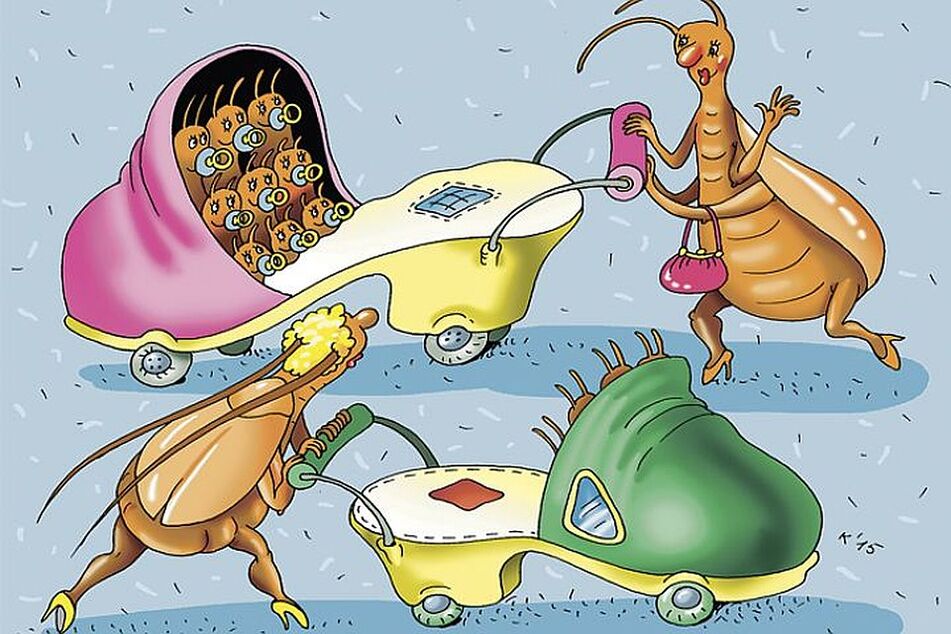
According to the World Health Organization, more than 4.5 billion people are infected with parasitic diseases in the world.This is not even every second person, but more!
In developing countries, their prevalence indicators are much higher than among the population of developed countries, which proves the influence of living standards and domestic conditions on these pests.Read about the most common of them below.
Bed bugs
Furniture, wallpaper, mattresses - all these are favorite habitats of small flat insects, known as bed bugs.They prefer to live next to people or pets in order to freely get out of their shelters at night to fell up warm human blood.
These bugs are not carriers of diseases, but can cause an allergic reaction.If the bites are very combed, an infection can be brought into the wound.Treat the place of the bite with an antiseptic or take an antihistamine.
Lice
These insects also eat human blood.And contrary to the prevailing opinion, they can live not only on the head, but in general with the whole body.
Lice is easiest to pick up through close contact with someone who already has them, and to fight with the help of various means, including special shampoos.
Scabies bugs
Barriers are caused by ticks that penetrate the skin and lay eggs there.And infection occurs with prolonged contact with the skin of a sick person.
Symptoms of scabies include itching, papulovesicular rash and the formation of a crust on the affected surface of the skin.It is treated with special drugs.
Pork chain
This parasite more often enters the human body with not sufficiently welded pork meat, but transmission is also possible in contact with feces of an infected person or animal.
The parasite affects the intestines and the brain, which leads to Cysticercosis - a disease causing headaches.Depending on the severity of the disease, treatment is either not carried out at all, or surgical methods are used.

Parasites build their lives next to us (and even in us), but we do not suspect this.
Naegleria Fowleri
Naegleria Fowleri is an amoeba that lives in warm fresh water, which is most common in Southeast Asia and enters the human body when bathing and water entering the nose.
It causes primary amo -bacon meningoencephalitis - a disease in which the brain is destroyed.Symptoms of the disease: headache, high temperature, vomiting, confusion, convulsions, impaired balance and loss of consciousness.At this time, there are only experimental drugs from such a disease, so survival with it is extremely low.
Round worms
A whole group of worms (ascarides, trichinelles, pinworms and so on).Most of them affect the intestines.But one species that causes trichinellosis parasitizes in the muscles.
The symptoms of infection with such parasites: abdominal pain (ascarides), blood loss and anemia (hokworms), itching in the anus (pinworms), pain, heat, facial edema, eye redness, skin rash (trichinella), mucus, liquid and blood in feces, damage to the mucous membrane of the colon (belly -headed).
You can get rid of such parasites with the help of drugs recommended by the doctor.
Intestinal lamblia
If, after a trip to nature, you began to torment such signs as diarrhea, bloating, cramps, nausea, then - do not go to the fortuneteller - this evil parasite has probably penetrated your body.You can get infected through food and water, as well as through contact with feces of an infected person or animal.Fortunately, it is treated quickly and not expensive medicines.
Trypanosoma
This parasite causes a life -threatening Shagas disease.The disease spreads with a special type of bugs.Symptoms - heat, fatigue, head and muscle pain, rash, loss of appetite, diarrhea, vomiting and edema of the eyelids - are manifested very quickly.
The disease can lead to chronic damage to the heart and intestines.The disease is treated with special drugs.
CryptosPoridiums
These parasites affect the intestines.They spread through contact with feces of an infected person or animal.Most often, infection occurs during bathing.The diarrhea caused by CryptosPoridiums can last a long time, but most often it does not require treatment.
Plasmodium Falciparum
The carriers of this parasite causing malaria are mosquitoes.This type of malaria is considered the most dangerous and causes more deaths than everyone else.
The symptoms are similar to the symptoms of influenza - chills, fever, sometimes nausea and vomiting.To establish a diagnosis, a laboratory blood test is required.The main thing to remember is - the sooner treatment is started, the more the patient has a chance to survive.
Trichomonad
This parasite causes a disease that is transmitted sexually called trichomoniasis.Most infected symptoms are absent.But some may feel itching, burning or irritation in the genital area.The disease is treated with antibiotics.
Dientamoeba Fragilis
Doctors still do not know how this parasite that affects the colon enters the body.In some, the disease proceeds asymptomatic, others complain of abdominal pain and diarrhea.
Dientamoeba Fragilis is found in all regions of the world.The doctor can prescribe special drugs to you to combat this microorganism.
Toxoplasm
This parasite feels at home in meat, water and cat feces.In people, toxoplasma causes a disease with a similar name - toxoplasmosis.And its symptoms sometimes resemble flu.
In pregnant women and people with weakened immunity, symptoms can be more serious, for example, with toxoplasmosis, cysts in muscles, brain and even ... eyes can form.If necessary, drug treatment is prescribed.
Guinean worm
The disease caused by this parasite (its scientific name - Dracunculus medinseSis) is practically not found in our time - due to the spread of information about precautions.The parasite enters the human body with the absorption of water, in which there were large -crushed crayfish infected with parasite larvae.
In the human body, they grow in the intestines, after which they migrate into the lymph vessels, and from there they penetrate the skin and are localized in the subcutaneous tissue.Among the symptoms there may be heat, edema and pain in the place of localization of the worm.But from the moment of infection, to the appearance of the first symptoms, a year can pass.And there is no treatment.























